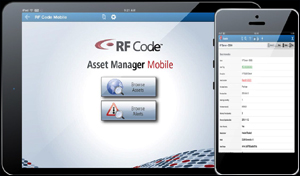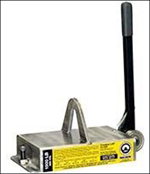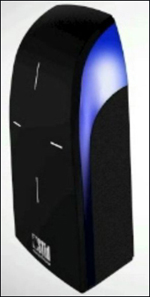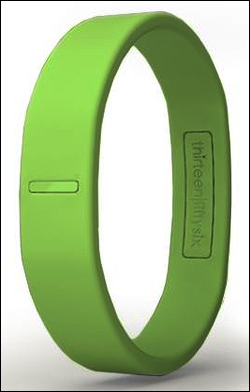The following are news announcements made during the past week by the following organizations: RF Code; Industrial Magnetics Inc.; InfoChip Systems; STid; Impinj; ThirteenFiftySix; Savi Technology; Haldor Advanced Technologies; and Belimed.
RF Code Launches New Mobile Management Platform for Data Centers
RF Code has announced Asset Manager Mobile, an asset-management software application for iPads, tablets and smartphones, as well as interactive desktop graphing and charting capabilities. According to the company, the software extends the reach of RF Code’s IT asset-tracking and environmental-monitoring solutions, and provides data-center managers with access to real-time data regarding their facilities, from any location and at any time. Within a dynamic environment, such as a data center, in which large technology enterprises have recorded as many as 45 percent of assets changing locations within a year, collecting real-time data—and being able to access that information at the actual time during which a process or event occurs—is an absolute necessity to effectively managing operations, the company says. The app, which runs on Apple iOS or Android devices, provides a global search feature to quickly access any location, asset or sensor defined in the system. Alert conditions (such as security violations, or elevated temperature or humidity readings) are also sent directly to the Asset Manager Mobile software, enabling immediate, proactive responses to critical issues. In addition, it includes reporting, charts and graphs that can be studied and drilled into for more specific details. The software works with RF Code’s 433 MHz active RFID tags and readers for asset and environmental monitoring. Asset Manager Mobile is designed to enable easy access to locate, browse, view, add, edit and delete assets and RFID tags. According to RF Code, several companies—including FedEx, Hewlett-Packard, Bloomberg, eBay, Vodafone and others—are currently using RF Code’s active RFID system to monitor assets and environmental conditions. Asset Manager Mobile is slated to be made available next month through the Apple App Store and Google play at no cost.
IMI’s Lifting Magnets Now Come With InfoChip RFID Technology
Industrial Magnetics Inc. (IMI), a provider of lifting magnets and magnetic separators used by manufacturers to extract metal from products, has announced its CreativeLift lifting magnet with RFID. The CreativeLift magnet, used for handling steel plates, die castings, forgings and other items, eliminates the need for clamping devices, slings or chains, according to IMI. The RFID technology is designed to make it easier and more accurate in identifying the lifts, as well as in tracking plant maintenance operations. The RFID technology, provided by InfoChip Systems, includes Near Field Communication (NFC) passive high-frequency (HF) 13.56 MHz RFID tags and handheld interrogators. A tag is affixed to the CreativeLift magnet, and maintenance and quality personnel can document the lift magnet’s location, inspection history, safety compliance and maintenance record, using the handhelds as part of their company’s control programs. IMI has been tagging its magnetic separators, which are employed at bulk-processing plants—particularly those operated by food companies striving to ensure that no stray metal ends up in products—since 2012 (see RFID Attracts Interest for Magnetic Separators).
STid Intros Modular HF RFID Access-Control Reader, Configurable Wirelessly Via Impinj Chip
French RFID firm STid has announced Architect, its new RFID-enabled, modular, secure access-control reader that leverages contactless chip technologies. The reader design features a common RFID core that can be placed inside a variety of polycarbonate casings, including one equipped with a keypad, a fingerprint sensor or a touchscreen, so each reader can be tailored to a customer’s specific needs. The reader can be also be customized with color and logos. The device is compatible with the ISO 14443A, ISO 14443B and ISO 18092 standards, and supports simultaneous reading of all chips in NXP Semiconductors‘s Mifare family: Ultralight, Classic (1 or 4 kilobytes), Ultralight C, Mifare Plus S and X (2 or 4 kilobytes), and DESFire. It also supports more specific products, such as the CPS3 card used by French health professionals (IAS protocol), Moneo and Near Field Communication (NFC) identification. The Architect can also be reprogrammed onsite to upgrade to future technological options, STid reports. The reinforced polycarbonate casing is rugged enough for both indoor and outdoor use, according to the company, while the core and modules (excluding the connectors) are rated IP 65, which means that testing has confirmed them to be dustproof and waterproof. Integrated into the Architect is an Impinj Monza X-2K Dura ultrahigh-frequency (UHF) RFID chip to enable the device to be configured via an EPC Gen 2 RFID reader. The Architect features a variety of data security mechanisms, implementing such public encryption algorithms as TDES, AES, RSA, HMAC-SHA-2 and more. The reader also features an accelerometer-based tamper-protection system; the accelerometer can sense tampering, and can alert a customer so that the reader’s authentication keys can be deleted. The firm also indicates it has received First Level Security Certification (CSPN), a high-level accreditation for information system security products governed by the Agence Nationale de la Sécurité des Systèmes d’Information (ANSSI), a French government agency. According to STid, the certification recognizes the company’s technological and security expertise.
Spanish Startup ThirteenFiftySix Developing NFC Wristband to Control Smartphones
A group of Spanish entrepreneurs have launched a company known as ThirteenFiftySix, to design a Near Field Communication (NFC)-enabled wristband that can automate various controls of smartphones. Pedro Martínez, who currently studies at Málaga University, has joined with five others to create the 13.56 personal wristband, which contains two passive 13.56 MHz NFC RFID tags encased in a flexible, natural rubber. The tags work with the company’s software, which runs as an application on an Android NFC-enabled smartphone, and each tag can be used to control various functions of the phone, including unlocking the phone, controlling the music (such as lowering the volume or advancing to the next song), managing the alarm, managing files and transferring contact information to another person’s smartphone. The tags invoke functions based on the smartphone’s status. For example, if the alarm sounds, the wristband wearer can tap one side of the wristband to the smartphone in order to turn it off, or tap the other side of the wristband to the phone to postpone that alarm. “The wristband only contains two different tags,” Martínez explains, “and the rest is made by the software that is able to manage different overlapping actions. For instance, if you are listening to music and the alarm is ringing, it would select the action with a higher priority—the alarm, in case of conflict.” On Sept. 16, ThirteenFiftySix launched its Kickstarter crowdfunding campaign in an effort to raise money to pay for the injection molds, components for the wristbands, labor costs, use of machinery and manufacturing, development of the application, packaging and shipping expenses, and legal expenses. The startup expects to ship the 13.56 wristbands and phone app by January 2014.
Savi Releases Savi Mobile Tracking System 2.4
Savi Technology has announced Savi Mobile Tracking System 2.4 (SMTS 2.4), a new release of software designed to provide more accurate operational insight and supply chain visibility. The SMTS software works with RFID tags and related sensors (such as those for monitoring temperature, humidity, light or pressure levels) to detect and transmit data regarding the loads being transported. According to Savi, the new release, SMTS 2.4, features intelligent alert capabilities that leverage the system’s ability to learn from organization, user and asset behaviors, and then apply that knowledge to future events. Combined with additional usability improvements and support of tags from multiple providers, the company reports, SMTS 2.4 can bridge gaps across enterprise and legacy systems caused by incomplete coverage, battery performance or intentional tampering—gaps that can affect the quality of sensor data. SMTS 2.4 enables the tag-agnostic approach and improves data accuracy by correcting and filtering sensor data, Savi explains. It also applies built-in logic to address out-of-sequence reads and event data received by sensors—which, according to the company, can improve the quality and accuracy of the operational information. The new data-filtering capability also reduces the number of false alerts triggered by the system, Savi claims. The usability improvements include features that make it easier for users to customize alert thresholds so they can be notified of unexpected changes in transport (such as going off route or excessive idling), or when assets arrive or depart specific areas. SMTS 2.4 automatically pushes this information to users, according to Savi, thereby enabling a faster response than systems requiring users to be actively using an application. The new release includes a larger asset map, improved icons and visual alerts, which Savi says make it possible for users to operate primarily from the map view. At a glance, users can identify the location and status of inventory, as well as high-volume locations or routes, and SMTS 2.4 also introduces a Detailed Asset Hover function that displays critical status, such as speed, direction, location and other criteria, by mouse-over. Users can drill down for even greater detail by clicking on assets directly from the map view, the company notes. In addition, SMTS 2.4 includes improved geocoding, which is used to locate assets, vehicles or shipments on a live map or within an established route area. New to SMTS 2.4 is reverse geo-coding, or the translation of latitude or longitude coordinates into an actual place on a map, such as a street address, an established site or an existing route. This immediately provides users with a more specific location identifier, which can be critical during such event as theft, mechanical breakdown or emergency response, according to Savi. One company currently using the Savi Mobile Tracking System platform is SGS, which is partnering with Savi to provide its OMNIS solution to help countries and organizations track and monitor cargo and shipments in real time (see RFID News Roundup: Savi Teams With SGS on Tracking Services, Intros New Software)
Belimed and Haldor Team Up on Real-Time Surgical Instrument-Management System
Belimed, a provider of cleaning and sterile processing systems and solutions in health care and life sciences, has announced a partnership with Haldor Advanced Technologies, which provides RFID-enabled surgical instrument management solutions for the health-care industry. Through this partnership, Belimed will market and sell Haldor’s ORLocate system as a complete solution in conjunction with Belimed’s processing equipment, in order to provide and document real-time information regarding each sterile processing cycle. Haldor’s ORLocate solution is designed to track and trace surgical sponges and instruments fitted with RFID tags, to help hospitals ensure that equipment and materials are not misplaced during surgery, either within a patient or in waste containers, and to track the use, maintenance and status of instruments in order to make sure they are properly handled, sterilized and used (see RFID News Roundup: Haldor Advanced Technologies Updates ORLocate Surgical-Instrument Tracking Platform). ORLocate tags comply with GS1‘s EPC Tag Data standard, while the ORLocate tags and readers operate in the high-frequency (HF) 13.56 MHz band, according to the ISO 15693 RFID standard. The partnership, according to the two companies, will enable Belimed to leverage Haldor’s real-time surgical instrument-management solutions to track the location and status of surgical instruments within sterile processing departments and operating rooms. The expected benefits include a reduction in the loss of surgical instruments, optimized repair and maintenance schedules for surgical instruments, an easier process of associating instruments to specific patients, and a decreased reprocessing of unused instruments. “This is the first true instrument tracking system at the instrument level, which covers the full continuum of Sterile Processing Department and OR, and doesn’t result in any additional workflow time,” said Joe McDonald, the president of Belimed’s Medical Group, in a prepared statement. “While tray level software has been in the marketplace for many years, this is the first real instrument level technology.”





